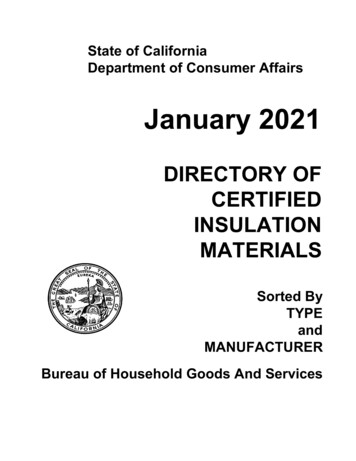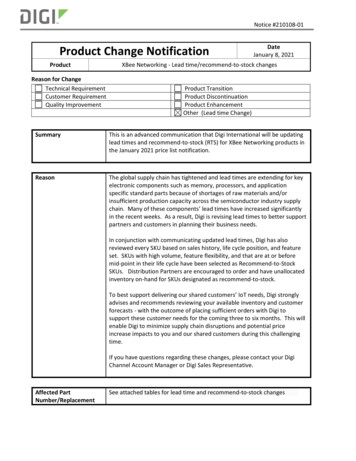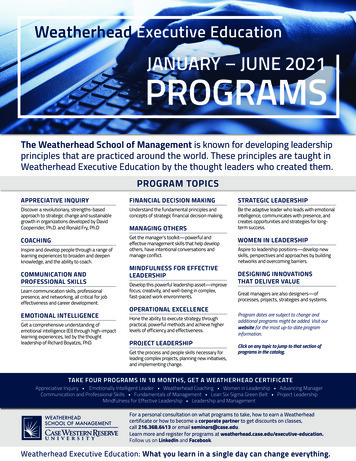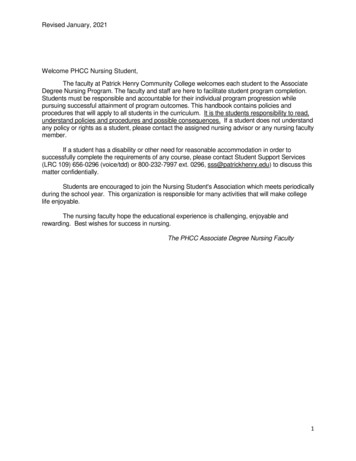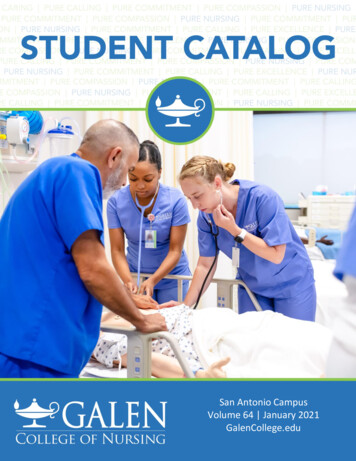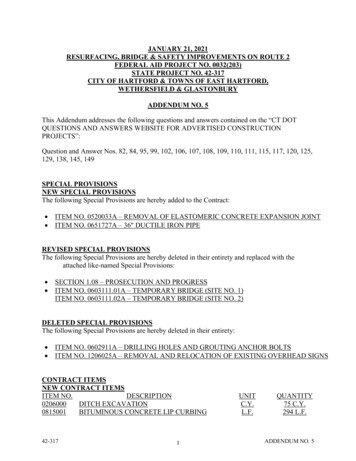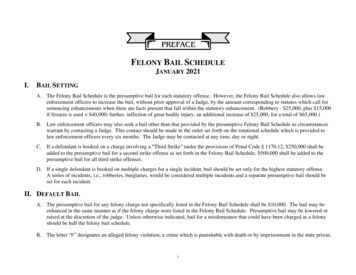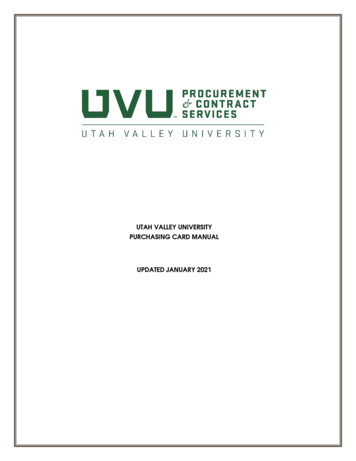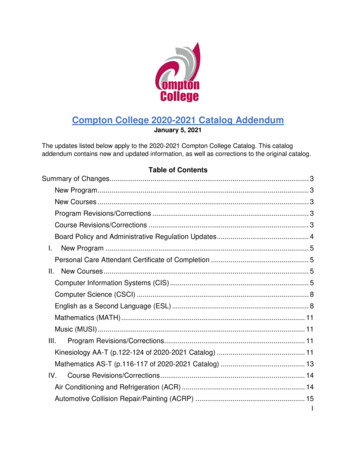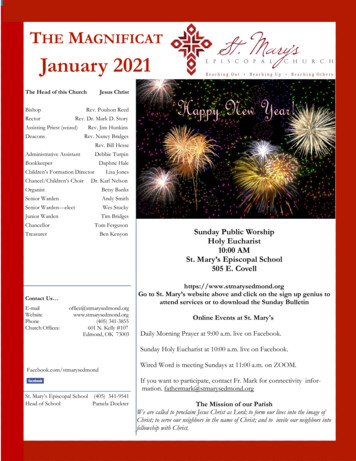
Transcription
VERSION 2 – JANUARY 20211
MECHANICAL / HVAC-RSYSTEMS POLICYVERSION 2 – JANUARY 20212
MECHANICAL / HVAC-RSYSTEMS POLICYTABLE OF CONTENTSIntroduction4Criteria for Temperature and Relative Humidity4HVAC-R System Evaluation for NHL Venues4Airflow Management: Ventilation and Filtration5Purge Cycles and Outdoor Air Flow6Air Filtration and Air Cleaning7Viral Inactivation Technologies7Compliance9Mechanical / HVAC-R Systems Policy Certification11VERSION 2 – JANUARY 20213
MECHANICAL / HVAC-RSYSTEMS POLICYINTRODUCTIONThe NHL recognizes the importance of indoor environmental quality (IEQ) in arenas and theoptimization of Heating, Ventilation, Air Conditioning and Refrigeration (HVAC-R) systems in NHLArenas and Practice Facilities to mitigate viral exposure from aerosolized particles. The AmericanSociety of Heating, Refrigerating and Air-Conditioning Engineers’ (ASHRAE) position statement1 onSARS-CoV-2 and the operation of HVAC-R systems in response to the COVID-19 pandemic states:Ventilation and filtration provided by heating, ventilating, and air-conditioning systemscan reduce the airborne concentration of SARS-CoV-2 and thus the risk of transmissionthrough the air.No intervention to prevent the transmission of COVID-19 is 100% effective, but risk levels arereduced when ventilation rates are increased2, air filtration (central and local) is enhanced andinactivation technologies are deployed3. In conjunction with third party experts, the NHL hasestablished requirements and recommendations for mechanical and HVAC-R systems intendedto mitigate the risk of transmission of COVID-19 in facilities. All facilities hosting NHL games orteam practices during the NHL’s 2020/21 season are to adhere to requirements of all applicablelocal regulations and building codes, including any further restrictions or direction (if any) by local,state, provincial, and federal health authorities.CRITERIA FOR TEMPERATURE AND RELATIVE HUMIDITYAt all times during NHL Game play, NHL Arenas’ HVAC-R system and operations should havethe ability to, and are required to, achieve and maintain temperature parameters at ice levelbetween 60 F -64 F and RH (Relative Humidity) levels of 40% to 45% during games.HVAC-R SYSTEM EVALUATION FOR NHL VENUESMechanical/HVAC-R Systems Evaluation4: The NHL recognizes that all NHL Arenas and PracticeFacilities (hereafter “Venues”) differ based on various factors such as building vintage, type ofHVAC-R systems currently installed, region-specific climatic considerations, and even day-specificoutdoor temperature and humidity conditions particularly during “shoulder-month” periods(typically late spring and early fall times of the year when daily temperatures can vary betweenabout 45 F and 65 F). The League further acknowledges that facilities where Clubs practice rangefrom older community rinks to newer, state-of-the-art facilities.Given the multitude of considerations, the NHL recommends Venues to undergo an HVAC-Rsystem review prior to hosting NHL games or team practices, where feasible, to understandcurrent HVAC-R system configuration and operations, and to inform proposed upgrades, retrofitsor enhancements to reduce risk of airborne viral transmission.While the above is recommended, each Club is required to perform an independent ventilationanalysis and air balance report (air handling unit-level Testing Adjusting Balancing (TAB) report)for all occupied spaces, which will confirm supply, outdoor air and exhaust ventilation rates by acertified TAB contractor, and establish whether the existing system is performing to the basis of itsASHRAE Statement Regarding Transmission of SARS-CoV-2 (Resources to Address COVID-19)ASHRAE Position Document on Infectious Aerosols, April 14, 2020. Section 3.2 Varying Approached for Facility Type, page 63ASHRAE Position Document on Infectious Aerosols, April 14, 2020. Section 3.2 Ventilation and Air-Cleaning Strategies, page 6 & 7, 104 ASHRAE Guidance for Re-Opening Buildings12VERSION 2 – JANUARY 2021ARENA RESTART PROTOCOLS 2020/214
MECHANICAL / HVAC-RSYSTEMS POLICYdesign. For clarity, the testing of individual VAV boxes and distribution ductwork in occupied spacesis not a requirement.In addition, please be advised of the following recommendations: All areas planned for occupancy should be analyzed to determine total Air Changes perHour (ACH) and Outdoor Air Changes per Hour (OACH), and an air change rate table for eachoccupied space should be developed to indicate the current rates for analysis. Expectedoccupancy counts for these areas should be provided as part of this overall review. Review central and local air filtration including Minimum Efficiency Reporting Values (MERV)ratings on existing filters to ensure they are within service life and appropriately installed.Review filter maintenance and replacement schedule as indicated in filter manufacturer’spublished operations manual. Consider independent review of supply and exhaust systems and controls including exhaustfan inspections by a mechanical contractor or commissioning agent.Venue operators both of NHL Arenas and Club Practice Facilities are encouraged to use aprofessional engineer to do an overall evaluation of the above considerations. The analysis of eachvenue may take between 2-4 weeks, or longer, based on industry demand and scope of work.AIRFLOW MANAGEMENT: VENTILATION AND FILTRATIONThe NHL recommends improving airflow (demonstrated by increasing ACH as compared to existingperformance levels) and increasing outdoor air flow rates to all occupied spaces, based on ananalysis of the venue’s existing configuration of the HVAC-R system and current air balance reportwith analysis by a professional engineer.Recommendations: Calibrate HVAC-R system controls and airflow measurement devices to coordinate withincreased outdoor airflow rates, particularly in areas such as team spaces (visiting andhome) back-of-house staff areas, and the main bowl area. Any mechanical system allowing for potentially contaminated exhaust air to bypass into theincoming outdoor air stream is not recommended and should be disabled. Proper separationof exhaust sources and intakes should be maintained, and energy recovery should becarefully controlled to limit any bypass airflow5. Venues should consider disabling automatic demand-controlled ventilation (DCV) systemconfigurations. CO2 Monitoring: Venues should consider monitoring CO2 levels in occupied spaces to accountfor any air pollution (parts per million) due to the increased outside air intake6. A note on CO2 Sensor Applications: Venues are encouraged to establish baseline CO2concentrations by monitoring each space, while unoccupied, prior to planned occupancy.If possible, simulate event occupancy of each space and chart CO2 levels at different occupancycounts. Establish maximum occupancy count such that CO2 levels are maintained below 1,000ASHRAE Position Document on Infectious Aerosols, April 14, 2020 Section 4.1ASHRAE Technical Resources: Filtration / Disinfection7ASHRAE 62.1 2016 Ventilation for Acceptable Indoor Air Quality Appendix D56VERSION 2 – JANUARY 2021ARENA RESTART PROTOCOLS 2020/215
MECHANICAL / HVAC-RSYSTEMS POLICYppm and implement procedures for reducing occupancy count in the event CO2 levels exceed1,000 ppm (Ref. ASHRAE 62.1-2016, Appendix D7) . During occupied periods, monitor CO2 levelsin occupied spaces and track whether ventilation systems are operating properly. If currentlyinstalled, CO2 sensors in return air systems serving occupied spaces may be utilized in lieu ofsensors in the occupied space level, in addition to any permanently mounted individual sensors,or handheld portable sensors. Install duct- or air-handling-unit-mounted UVGI, upper-room UVGI (with possible in-roomfans) or portable UVGI air treatment technology to treat the supply air flow, in order toinactivate airborne viruses particularly in high occupancy spaces, team spaces, back of housestaff areas or mission-critical operations areas like Security and Command Center-typerooms. See section: Viral Inactivation Technologies below for further information. In elevators, implement local treatment such as UVGI technology or HEPA filtration wheredirect ventilation is not present or not practical, due to the inability to ventilate the elevatorcab. Venues are encouraged to obtain industrial hygienist and medical guidance for furtherconsideration on elevator ventilation concerns, and to implement appropriate occupancycount limits as may be recommended. In all restrooms, locker rooms, wet areas and showers, engage exhaust systems to runcontinuously during occupancy8. If the HVAC-R system cycles on/off with a thermostat,run the fan constantly during occupied hours.PURGE CYCLES AND OUTDOOR AIR FLOWIn addition to the airflow management guidance above, per ASHRAE general guidance9, pre- andpost-occupancy purge cycles are outlined below for Team Spaces, and Other Occupied Spaces (NonTeam Spaces) in NHL Venues:Team Spaces Prior to each occupancy by Players and staff (e.g., Groups 1 and 2A-C), the NHL requiresflushing all home and visiting Team Spaces with outdoor air for a time required to achievethree air changes of outdoor air10 (3 OAC). Such team spaces include, without limitation,changing rooms, locker areas, weight rooms, training rooms, medical rooms, coachesroom, equipment room, strength and conditioning areas, rehabilitation areas and eating orrecreation lounge-type spaces areas. For HVAC-R systems serving such occupied spaces that are unable to achieve 3 OAC,the venue must attempt to achieve six air changes per hour11 (6 ACHs). Venues shallseek assistance from a professional engineer, infectious disease specialist or industrialhygienist to assess their specific needs for this evaluation. Post-occupancy, the NHL recommends the continued operation of the HVAC-R ventilationsystem for approximately 1 hour12 to achieve 6 ACHs. In facilities with nighttime setbackASHRAE Guidance for Polling Place HVAC-R Systems page 2ASHRAE Technical Resources/Building Readiness Guide; Section: Pre- or Post-Occupancy Flushing Strategy10ASHRAE Guidance for Reopening Buildings; Section: Pre- or Post-Occupancy Flushing Strategy11CDC Ventilation requirements for areas affecting patient care in hospitals and outpatient facilities Appendix B. Air - Section 4 Table B-212 CDC Ventilation requirements for areas affecting patient care in hospitals and outpatient facilities Appendix B. Air Section 1 Table B-189VERSION 2 – JANUARY 2021ARENA RESTART PROTOCOLS 2020/216
MECHANICAL / HVAC-RSYSTEMS POLICYmodes, the NHL recommends disabling those settings or at a minimum overriding them toallow for the system flush after occupied periods.Other Occupied Spaces (Non-Team Spaces) The NHL recommends flushing all Other Occupied Spaces with outdoor air for a timerequired to achieve three air changes of outdoor air13 (3 OAC) prior to significant occupancyof the arena and between consecutive spectator events. For HVAC-R systems serving occupied spaces that may not be able to achieve 3 OAC, or insituations where the arena bowl ventilation system may not have the capacity to conditionoutdoor air per the recommendation above while maintaining NHL criteria for temperatureand relative humidity for ice conditions, the venue may consider an equivalent of 3 OACwhich may include effect of outdoor air, particulate filtration and air cleaners14 (see belowsection: Viral Inactivation Technologies). Venues are encouraged to seek assistance from aprofessional engineer to assess their specific needs for this evaluation.AIR FILTRATION AND AIR CLEANINGPer ASHRAE Position Document on Filtration and Air Cleaning (January 2015)15, filtration and aircleaning can be used to improve indoor air quality and to mitigate airborne viral transmission.The NHL recommends improving central air and other local HVAC-R filtration above codeminimums to MERV-13 (ASHRAE 2017b) or the highest level achievable, without impacting systemair flow and pressure based on existing HVAC-R system configuration. Consult with a professionalengineer or qualified professional to determine the appropriate scope of this work. Venues shouldreview filter maintenance and replacement schedules; filter replacements should be achieved asindicated in filter manufacturer’s published operations manual.For enhanced air cleaning, particularly in areas with low air flow, in high occupancy spaces, backof house staff areas or mission-critical operations areas like Security and Command Center-typerooms, Venues should consider deploying additional portable room air cleaners with HEPA orhigh-MERV filters with due consideration to the Clean Air Delivery Rate (CADR)16 (AHAM 2015)17.VIRAL INACTIVATION TECHNOLOGIESThere are numerous technologies that may actively kill or inactivate organics, including viruses, inairstreams and/or on surfaces. There are HVAC unit-mounted options, products installed in centralair handlers, and in-space options for use in occupied rooms or in guest-accessible spaces. Thefollowing technologies are deployed in varying capacities in sports and entertainment venues andare worth considering, particularly in occupied spaces with lower air change rates. At this time,neither ASHRAE nor the CDC specifically recommend nor warn against their use.Additionally, the NHL continues to monitor guidance from both ASHRAE and CDC as well as otherindustry experts and authorities on appropriate guidance regarding COVID-mitigating technologiesand their efficacy in real-world applications.ASHRAE Guidance for Reopening Buildings; Section: Pre- or Post-Occupancy Flushing StrategyASHRAE Guidance for Reopening Buildings; Section: Pre- or Post-Occupancy Flushing Strategy15ASHRAE Position Document on Filtration and Air Cleaning (January 2015)16ASHRAE Position Document on Infectious Aerosols (April 2020) Section 4.117 Association of Home Appliance Manufacturers AHAM AC-1-2015 Method for Measuring Performance of Portable Hous
ASHRAE 62.1 2016 Ventilation for Acceptable Indoor Air Quality Appendix D. VERSION 2 fi JANUAR 2021 6 ppm and implement procedures for reducing occupancy count in the event CO2 levels exceed 1,000 ppm (Ref. ASHRAE 62.1-2016, Appendix D7) . During occupied periods, monitor CO2 levels in occupied spaces and track whether ventilation systems are operating properly. If currently

